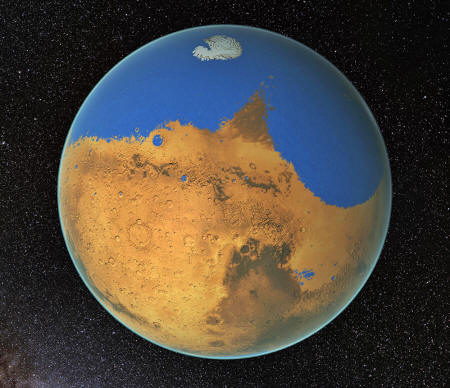|
|
|
March 5, 2015
NASA scientists have determined that a primitive ocean on Mars held more water than Earth's Arctic Ocean and that the Red Planet
has lost 87 percent of
that water to space.
Details of the observations and computations appear in Thursday's edition of Science magazine.
Perhaps about 4.3 billion years ago, Mars would have had enough water to cover its entire surface in a liquid layer about 450 feet (137 meters) deep.
More likely, the water would have formed an ocean
occupying almost half of Mars' northern hemisphere, in some regions
reaching depths greater than a mile (1.6 kilometers).
With these powerful instruments, the researchers distinguished the chemical signatures of two slightly different forms of water in Mars' atmosphere.
One is the familiar H2O. The
other is HDO (Deuterium protium oxide), a naturally occurring variation in which one hydrogen
is replaced by a heavier form, called
deuterium.
The
resulting data produced global snapshots of each compound, as well
as their ratio. These first-of-their-kind maps reveal regional
variations called microclimates and seasonal changes, even though
modern Mars is essentially a desert.
The
enrichment of the ice caps told them how much water Mars must have
lost - a volume 6.5 times larger than the volume in the polar caps
now. That means the volume of Mars' early ocean must have been at
least 20 million cubic kilometers (5 million cubic miles).
An ancient ocean there would have covered 19 percent of the planet's surface.
By comparison, the Atlantic Ocean occupies 17 percent of Earth's surface.
NASA is studying Mars with a host of spacecraft and rovers under the agency's Mars Exploration Program, including,
In 2016, a Mars lander mission called InSight will launch to take a first look into the deep interior of Mars.
The agency also is participating in ESA's (European Space Agency) 2016 and 2018 ExoMars missions, including providing telecommunication radios to ESA's 2016 orbiter and a critical element of the astrobiology instrument on the 2018 ExoMars rover.
NASA's next rover, heading to Mars in 2020, will
carry instruments to conduct unprecedented science and exploration
technology investigations on the Red Planet.
In parallel, NASA is developing the human spaceflight capabilities needed for future round-trip missions to Mars in the 2030s.
NASA - Measuring Mars' Ancient Ocean
|


